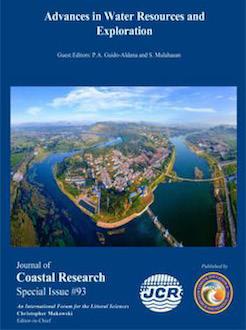Zhang, X.; He, J.; Ren, Z.; Zhou, T.; Shi, S., and Zhao, Y., 2019. Paleo-lake water stratification in the Chang 7 Age of the triassic and its significance for shale gas accumulation in the Ordos Basin. In: Guido-Aldana, P.A. and Mulahasan, S. (eds.), Advances in Water Resources and Exploration. Journal of Coastal Research, Special Issue No. 93, pp. 170–177. Coconut Creek (Florida), ISSN 0749-0208.
As the second largest sedimentary basin in China, the Ordos Basin experienced a peak age of paleo-lake transgression during Chang 7 Age of Triassic. The best source rocks of Mesozoic in the whole basin have been formed together with this transgression. The relationship between water stratification of the paleo-lake in Chang 7 Age and the shale development characteristics of Chang 7 formation can provide a scientific basis for researches of shale gas reservoir formation. In this paper, the paleo-climatic, depth, distribution and salinity of paleo-lake in Chang 7 Age, as well as the geochemical and mineralogical characteristics of the Chang 7 shale, are analyzed. Comparing with water stratification characteristics in present-day oceans and lakes from previous studies, the water stratification characteristics of paleo-lake in Chang 7 Age has been concluded. The water stratification was widely distributed by temperature stratification, which could lead indirectly to salinity stratification. Large areas of stably stratified water increased the abundance of organic matter, the content of brittle minerals in the shales, and resulted in well-developed laminated organic shales. All of these are of great significance to the formation of Chang 7 shale gas reservoir.





